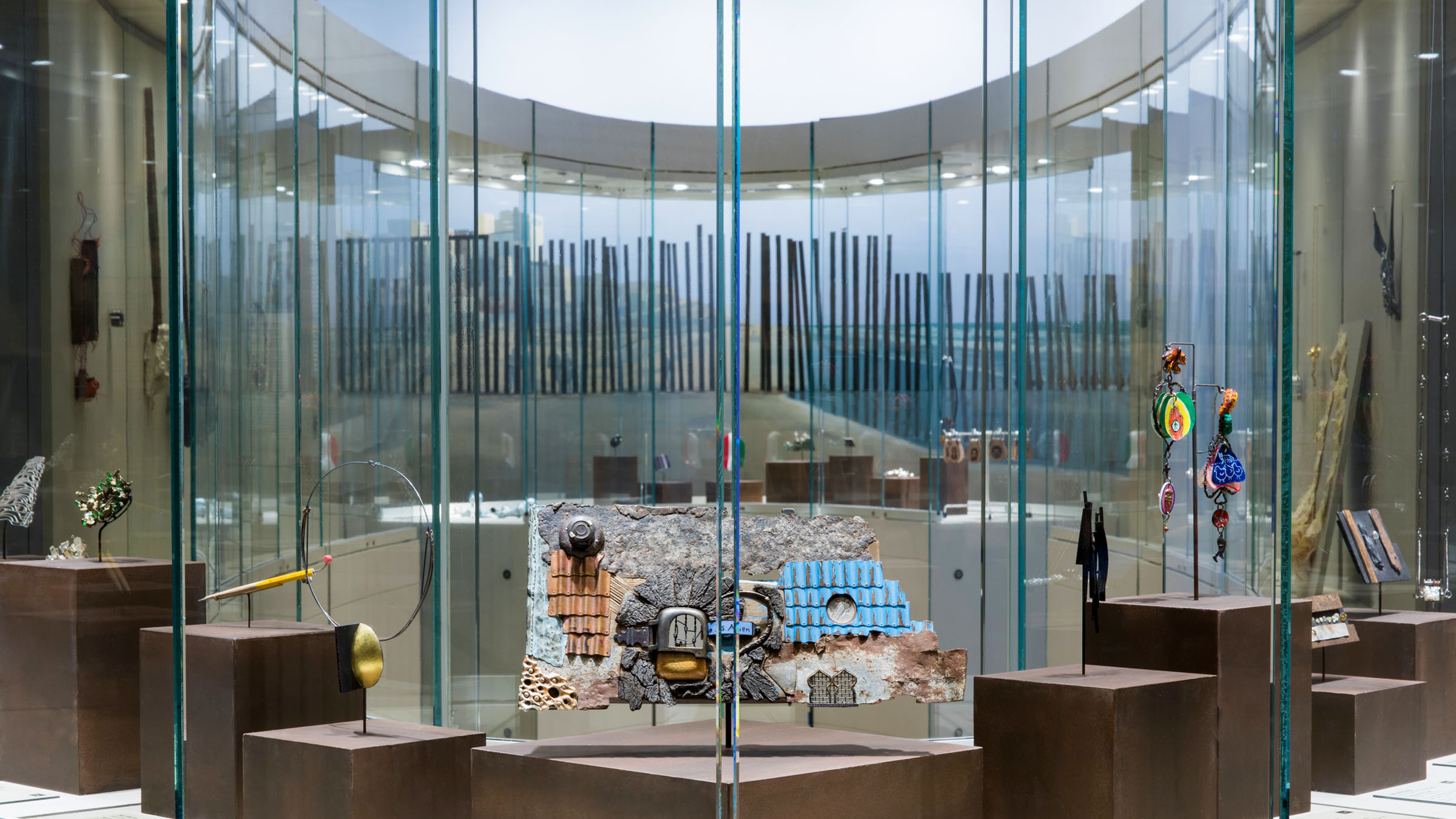Understanding La Frontera

The 2018 exhibition La Frontera: Encounters Along the Border presented jewelry created by artists from Mexico, the United States, Europe, and Latin America inspired by the lives of those impacted by the border between the United States and Mexico. In this previously published exhibition essay, curator Barbara Paris Gifford discusses how La Frontera is a response to President Donald J. Trump's proposed border wall.
Spanning 1,989 miles, from the Pacific Ocean to the Gulf of Mexico, the US–Mexico frontera is the most frequently crossed border in the world. The border zones are among the fastest-growing regions in both countries, with over $1 billion in transborder trade transacted daily. Since the 2016 presidential election, however, relations between the United States and Mexico have reached a crucial point with Donald J. Trump’s desire to build a new, impenetrable border wall. The construction of such a large-scale fortification would not only impact commerce but also significantly affect millions of people—transborder citizens on both sides, Mexican families already in the US, and those seeking to cross in pursuit of a better life—as well as threaten wildlife in the Sonoran Desert.
In this critical moment of US-Mexico history, La Frontera: Encounters Along the Border seeks to tell the stories of the everyday people whose lives the border has touched and to build empathy for those who aspire to cross it. Porous in nature, the frontera allows for the exchange of ideas, wealth, and culture, embodying the deeply rooted interdependence between these two countries. Through the intimate medium of jewelry, the international exhibition explores this space as a complex physical, economic, cultural, social, and emotional landscape of human interaction.
Historically, the fortification of the border has largely been initiated by the United States. The dividing line between the US and Mexico was not formally established until 1848, following the end of the Mexican-American War. Nearly a century later, in 1945, the US built the first physical border, a 5-mile-long chain-link fence near Calexico, California. In the mid-1990s, border fences were erected opposite the Mexican cities of Tijuana, Nogales, and Ciudad Juárez, and after September 11, 2001, the US installed another 651 miles of border fencing, reinforced by Border Patrol agents and ICE (Immigration and Customs Enforcement) personnel, electronic and airborne surveillance, highway checkpoints, and even on occasion the National Guard. Today, parts of the US–Mexico borderlands resemble a military zone of occupation.
Despite these measures, the intertwined relationship between the countries continued to deepen. Border cities have grown to share an identity, a history, traditions, and livelihoods, such that transborder citizens often have more in common with each other than with people from their countries of origin.[i] As of 2014, thirty-six million people of Mexican descent lived in the United States, which continues to rely on Mexican labor in a variety of industries.[ii] Yet Mexican inflows have declined in recent years. As of 2013, more Mexican immigrants have returned to Mexico each year than have migrated to the US, and China and India have surpassed Mexico as the top source of new immigrants.[iii] Additionally, the number of people caught crossing the border without papers has dropped by 82% since its peak in 2000.[iv]
Ignoring these data in favor of an anti-immigration stance, Trump promised to build a border wall as part of his presidential campaign. On January 25, 2017, five days after his inauguration, he signed Executive Order 13767 to authorize the wall, extending and replacing the border fences that already exist. In October, the Department of Homeland Security (DHS) unveiled eight border wall prototypes, which as of this printing are undergoing testing for effectiveness. DHS projects the cost of the wall to exceed $21.6 billion. Though hotly debated in Congress, the new border wall seems likely to be approved.
La Frontera: Encounters Along the Border reveals the people who have been obscured by the politics. Inspired by the diverse environments and nationalities of the borderlands, the artists in the exhibition have transformed metal, fiber, wood, and other materials into representations of the border journey—the dreams and fears of those who long to cross, the opportunity they seek, the loss and danger they stand to face. The jewelry on display, in emphasizing the human experience of the border, exposes the absurdity of artificial divisions. As contemporary jeweler Boline Strand writes in her artist’s statement, “Nothing can obscure the fact that all Americans, unless descended from Native Americans or ancestors who were brought here quite literally in shackles, originate from immigrants to this country.” Or, in the words of artist Andrés Fonseca, “We are all border people.”
[i] For more information, see Michael Dear, Why Walls Won’t Work: Repairing the US–Mexico Divide (New York: Oxford University Press, 2015).
[ii] Jie Zong and Jeanne Batalova, “Mexican Immigrants in the United States,” Migration Policy Institute, October 9, 2014.
[iii] Renee Stepler and Mark Hugo Lopez, “U.S. Latino Population Growth and Dispersion Has Slowed since Onset of the Great Recession,” Pew Research Center, September 8, 2016.
[iv] Sarah Almukhtar and Josh Williams, “Trump Wants a Border Wall. See What’s in Place Already,” New York Times, February 5, 2018.
Subscribe
Join our mailing list.
Join
Become a member and enjoy free admission.
Visit
Find out what's on view.